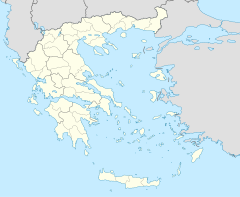Fanari railway station

Φανάρι Fanari | |||||||||||||||
|---|---|---|---|---|---|---|---|---|---|---|---|---|---|---|---|
| General information | |||||||||||||||
| Location | Kompelos 431 00, Karditsa Greece | ||||||||||||||
| Coordinates | 39°25′01″N 21°49′03″E / 39.416813°N 21.817440°E | ||||||||||||||
| Owned by | GAIAOSE[1] | ||||||||||||||
| Line(s) | Palaiofarsalos–Kalambaka railway[2] | ||||||||||||||
| Platforms | 1 | ||||||||||||||
| Tracks | 1 | ||||||||||||||
| Train operators | Hellenic Train | ||||||||||||||
| Construction | |||||||||||||||
| Structure type | at-grade | ||||||||||||||
| Platform levels | 1 | ||||||||||||||
| Parking | Yes | ||||||||||||||
| Bicycle facilities | No | ||||||||||||||
| Other information | |||||||||||||||
| Status | Unstaffed | ||||||||||||||
| Website | http://www.ose.gr/en/ | ||||||||||||||
| History | |||||||||||||||
| Opened | 16 June 1886 | ||||||||||||||
| Rebuilt | 2001 | ||||||||||||||
| Electrified | No[2] | ||||||||||||||
| Services | |||||||||||||||
| |||||||||||||||
| Former service | |||||||||||||||
| |||||||||||||||
| |||||||||||||||
Fanari railway station (Greek: Σιδηροδρομικός σταθμός Φαναρίου, romanized: Sidirodromikós stathmós Fanari) is a small railway station in the Karditsa regional unit, Thessaly. Located with a farming community of the same name, it opened on 16 June 1886 by the Thessaly Railways (now part of OSE). Today TrainOSE operates both regional and intercity services to destinations across Greece.
History
[edit]The station open 16 June 1886 by the Thessaly Railways.[3] The original station building (and the line) was designed by the Italian Evaristo de Chirico, (father of Giorgio de Chirico). The Greek government authorised the line under the law AMH'/22.6.1882.[4] soon after the liberation of Central Greece from the Ottomans.
After the First World War, the Greek state planned the ambitious construction of several new rail lines and links, including a standard gauge line from Kalambaka on to Kozani and then Veroia creating a conversion of the route from Volos to Kalambaka on standard gauge. In 1927, the relevant decisions were made, starting in 1928, work was carried out on the construction of the new line from Kalambaka. But a year later, it was clear that the project would exceed the estimated costs many times over. In 1932, the construction work was stopped and remains unfinished.[5] In 1955 Thessaly Railways was absorbed into Hellenic State Railways (SEK).[4]
Freight traffic declined sharply when the state-imposed monopoly of OSE for transporting agricultural products and fertilizers ended in the early 1990s. Many small stations of the network with little passenger traffic were closed down, especially on the mainline section and between Karditsa and Kalampaka. In 2001 the section between Kalampaka and Palaiofarsalos was converted from Narrow-gauge (1000 mm) to standard gauge (1435 mm) and physically connected at Palaiofarsalos with the mainline from Athens to Thessaloniki.[6] Since to upgrade; however, travel times improved and the unification of rail gauge allowed direct services, even InterCity services, to link Volos and Kalambaka with Athens and Thessaloniki.
In 2001, the infrastructure element of OSE was created, known as GAIAOSE; it would henceforth be responsible for the maintenance of stations, bridges, and other elements of the network, as well as the leasing and the sale of railway assists.[1] In 2005, TrainOSE was created as a brand within OSE to concentrate on rail services and passenger interface. In 2009, with the Greek debt crisis unfolding OSE's Management was forced to reduce services across the network. Timetables were cut back, and routes closed as the government-run entity attempted to reduce overheads. In 2015, a 15-year-old child was airlifted to a hospital after being electrocuted at the station.[7] In 2017 OSE's passenger transport sector was privatized as TrainOSE; currently, a wholly-owned subsidiary of Ferrovie dello Stato Italiane[8] infrastructure, including stations, remained under the control of OSE. In July 2022, the station began being served by Hellenic Train, the rebranded TranOSE.[9]
Facilities
[edit]The Station is now a basic halt, with few facilities. There are no waiting rooms (as the station building is rundown and seemingly abandoned. The station is (as of 2020) unstaffed, with no ticket-purchasing facilities or parking.
Services
[edit]Today, the station is served by direct lines to the rest of Greece via Palaiofarsalos, served by intercity trains to Athens, Palaiofarsalos Larissa and Thessaloniki.[10] Previously Thessaly Railways operated a narrow gauge service to Volos.[11]
In August 2009, TrainOSE S.A. proceeded to a drastic cutback of passenger services on Thessaly lines.[12] As of Spring 2020, There are ten (five in each direction) Regional express services on Palaiofarsalos-Kalambaka Line. In addition, there is one Regional express train to Athens from Kalambaka and back (884/885).
References
[edit]- ^ a b "Home". gaiaose.com.
- ^ a b "Annexes". Network Statement (PDF) (2023 ed.). Athens: Hellenic Railways Organization. 17 January 2023. pp. 1–2. Archived from the original on 2 October 2023. Retrieved 24 September 2023.
{{cite book}}: CS1 maint: bot: original URL status unknown (link) - ^ The historic Railway Station of Volos - TrainOSE
- ^ a b "HistoryEN | Thessaly Museum Railways". Archived from the original on 2020-07-28. Retrieved 2021-02-02.
- ^ Alexandros C. Gregoriou "The Kalambaka - Kozani - Veroia railway 1928 - 1932 (Kopie im Internet Archive)". Archived from the original on April 1, 2009. Retrieved February 2, 2021.
- ^ "Upgrading of Paleofarsalos – Kalambaka line". ΕΡΓΟΣΕ. 20 March 2018. Retrieved 2019-01-03.
- ^ "Alexandriamou.gr - Τραυματισμός Ατόμου από Ηλεκτροπληξία στο σιδηροδρομικού σταθμό Λεπτοκαρυάς Πιερίας".
- ^ "It's a new day for TRAINOSE as FS acquires the entirety of the company's shares". ypodomes.com. Retrieved 14 September 2017.
- ^ "TrainOSE renamed Hellenic Train, eyes expansion". Kathimerini. 2 July 2022. Retrieved 14 August 2022.
- ^ "Δρομολόγια ΤΡΑΙΝΟΣΕ". Archived from the original on 2023-03-20. Retrieved 2021-02-02.
- ^ "The Pelion Train, a mythical route". TrainOSE. Retrieved 2019-01-03.
- ^ TrainOSE S.A. "Timetables 1 August 2009", Tables 4A/B, 5A/B
